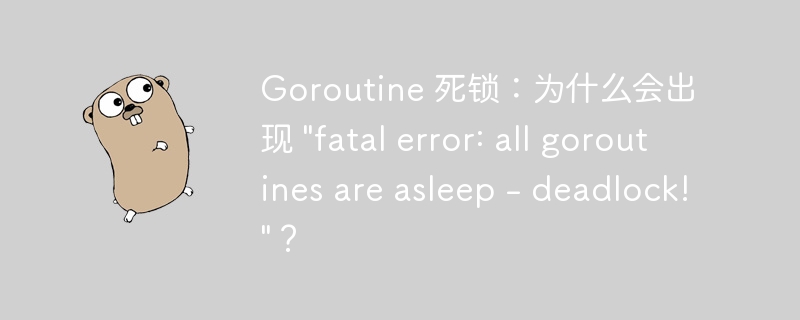最近发现不少小伙伴都对
GOLANG很感兴趣,所以今天继续给大家介绍
GOLANG相关的知识,本文
《Goroutine 死锁:为什么会出现 “fatal error: all goroutines are asleep – deadlock!”?》主要内容涉及到
等等知识点,希望能帮到你!当然如果阅读本文时存在不同想法,可以在评论中表达,但是请勿使用过激的措辞~,
 ,
,
goroutine 死锁: 为什么会出现 fatal error,在并发编程中,goroutine 死锁是一个常见问题。让我们通过一个代码示例来理解为什么会出现 “fatal error: all goroutines are asleep – deadlock!”。,这个代码使用两个 chan (a 和 b) 在两个 goroutine 之间进行通信。它使用 waitgroup 为主 goroutine 等待两个 goroutine 完成。,问题出在 b goroutine 执行的最后一次循环迭代。在这个迭代中,b goroutine 发送 true 到 a 并退出。但是,此时 a goroutine 已经没有机会接收该消息,因为它正在等待 b goroutine 发送 true。因此,程序进入死锁状态。,要解决此问题,可以在 b goroutine 的最后一次迭代中添加一个额外的接收操作。这将确保 a goroutine 有机会处理 b goroutine 的最后一条消息,从而避免死锁。,修改后的代码如下:,文中关于的知识介绍,希望对你的学习有所帮助!若是受益匪浅,那就动动鼠标收藏这篇《Goroutine 死锁:为什么会出现 “fatal error: all goroutines are asleep – deadlock!”?》文章吧,也可关注GOLANG公众号了解相关技术文章。,goroutine 死锁: 为什么会出现 fatal error,最近发现不少小伙伴都对
GOLANG很感兴趣,所以今天继续给大家介绍
GOLANG相关的知识,本文
《Goroutine 死锁:为什么会出现 “fatal error: all goroutines are asleep – deadlock!”?》主要内容涉及到
等等知识点,希望能帮到你!当然如果阅读本文时存在不同想法,可以在评论中表达,但是请勿使用过激的措辞~,
当前位置: > > > > Goroutine 死锁:为什么会出现 “fatal error: all goroutines are asleep – deadlock!”?
Goroutine 死锁:为什么会出现 “fatal error: all goroutines are asleep – deadlock!”?
2024-11-10 09:51:57
0浏览
收藏
最近发现不少小伙伴都对GOLANG很感兴趣,所以今天继续给大家介绍GOLANG相关的知识,本文《Goroutine 死锁:为什么会出现 “fatal error: all goroutines are asleep – deadlock!”?》主要内容涉及到等等知识点,希望能帮到你!当然如果阅读本文时存在不同想法,可以在评论中表达,但是请勿使用过激的措辞~

goroutine 死锁: 为什么会出现 fatal error
在并发编程中,goroutine 死锁是一个常见问题。让我们通过一个代码示例来理解为什么会出现 “fatal error: all goroutines are asleep – deadlock!”。
func main() {
a := make(chan bool)
b := make(chan bool)
defer close(a)
defer close(b)
var wg sync.waitgroup
wg.add(2)
go func() {
for i := 0; i < 10; i += 2 {
if <-a {
fmt.println(i)
b <- true
}
}
wg.done()
}()
go func() {
for i := 1; i < 10; i += 2 {
if <-b {
fmt.println(i)
a <- true
}
}
wg.done()
}()
a <- true
wg.wait()
}
这个代码使用两个 chan (a 和 b) 在两个 goroutine 之间进行通信。它使用 waitgroup 为主 goroutine 等待两个 goroutine 完成。
问题出在 b goroutine 执行的最后一次循环迭代。在这个迭代中,b goroutine 发送 true 到 a 并退出。但是,此时 a goroutine 已经没有机会接收该消息,因为它正在等待 b goroutine 发送 true。因此,程序进入死锁状态。
要解决此问题,可以在 b goroutine 的最后一次迭代中添加一个额外的接收操作。这将确保 a goroutine 有机会处理 b goroutine 的最后一条消息,从而避免死锁。
修改后的代码如下:
func main() {
A := make(chan bool)
B := make(chan bool)
defer close(A)
defer close(B)
var wg sync.WaitGroup
wg.Add(2)
go func() {
for i := 0; i < 10; i += 2 {
if <-A {
fmt.Println(i)
B <- true
}
}
<-A // 额外的接收操作
wg.Done()
}()
go func() {
for i := 1; i < 10; i += 2 {
if <-B {
fmt.Println(i)
A <- true
}
}
wg.Done()
}()
A <- true
wg.Wait()
}
文中关于的知识介绍,希望对你的学习有所帮助!若是受益匪浅,那就动动鼠标收藏这篇《Goroutine 死锁:为什么会出现 “fatal error: all goroutines are asleep – deadlock!”?》文章吧,也可关注GOLANG公众号了解相关技术文章。
- 如何使用Echarts自定义多类型MarkPoint?
- 如何在 JavaScript 中为 DOM 元素添加属性而不设置值?


